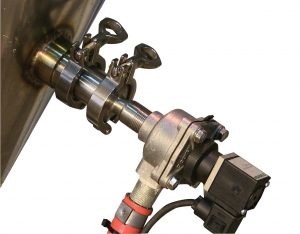
An aviation company that deices planes and runways uses pellets that are made of salt, binder, and other additives. Unfortunately, these materials are hygroscopic and have a tendency to clump and harden. The maintenance supervisor considered many different flow aids, but once he saw its description of “gentle vibration” he knew it wouldn’t work. “We needed something more…violent,” he said. He needed AirSweep.
When he saw an AirSweep video, he knew it was the solution they were looking for. The powerful air pulses could cut through moist and sticky materials like liquid cheese, heavy solids like gravel, and hygroscopic powders like cornstarch and titanium dioxide.
AirSweep Material Activation – More material moved per pulse
One AirSweep unit can activate more material than a dozen fluidizers. You can see this for yourself in this video that compares the two flow aids’ activation radius:
The smallest AirSweep, or model VA-06, activates a 1 to 2 foot radius, or about 300 to 600 millimeters. The AirSweep VA-12 activates a radius of about 3 to 4 feet, about 0.9 to 1.2 meters. The AirSweep VA-51 puts out a little more volume, so it activates a radius of up to 4 feet, or 1.2 meters, often even with denser products.
The role of pressure and volume
AirSweep harnesses air pressure and volume so each pulse can break material blocks and sweep them back into the flow stream. That’s why the system needs to have large pipes, headers, and receivers to run effectively.
Paul the AirSweep guy explains how this works, using the analogy of a garden hose and a fire hose.
AirSweeep is Powerful but energy efficient
Though AirSweep pulses require more plant CFM, it actually uses less energy and plant air than other flow aids.
AirSweep units are pulsed and run in a sequence, so even if you have 10 units on a vessel, they only pulse one at a time. It is more efficient than vibrators or fluidizers, which run continuously.
The AirSweep also uses less energy than air cannons and actually activates more material. One of the world’s largest cement companies had issues with clinker sticking to vessels and chutes. They tried using two AIRCHOC air cannons, but workers still had to use a bar to break the material.
AirSweep was an effective, fast, and simple solution. They were able to install it themselves in less than a day, and they never had to worry about clinker again. They even ordered 13 additional units for their various factories. “AirSweep works perfectly.”
Contact us to find out more about the AirSweep system, and how to set up one in your plant.





Comments are closed